5 Game-Changing Google Analytics Reports to Elevate Your Marketing Strategy
Harnessing the full potential of Google Analytics 4 (GA4) is essential for crafting marketing strategies that truly connect with your target audience and their behaviors. While the GA4 interface may initially seem daunting, it offers rich insights that can transform your understanding of customer interactions if you take the time to learn its features. Mastering GA4 will allow you to delve deep into the analytics, revealing critical information about your customer base and preferences. Let’s delve into five pivotal GA4 reports that can significantly enhance your marketing efforts and drive better engagement.
1. Traffic Acquisition Report: Uncover the Key Sources Driving Your Website Traffic
Have you ever thought deeply about where your website traffic originates? The Traffic Acquisition report serves as your essential tool for uncovering this crucial information. This insightful report breaks down the various channels that lead visitors to your site, illuminating key marketing pathways such as organic search, paid advertising, social media, and referrals. By analysing these channels, you will develop a nuanced understanding of your audience's origins, empowering you to focus your marketing efforts on the most effective strategies.
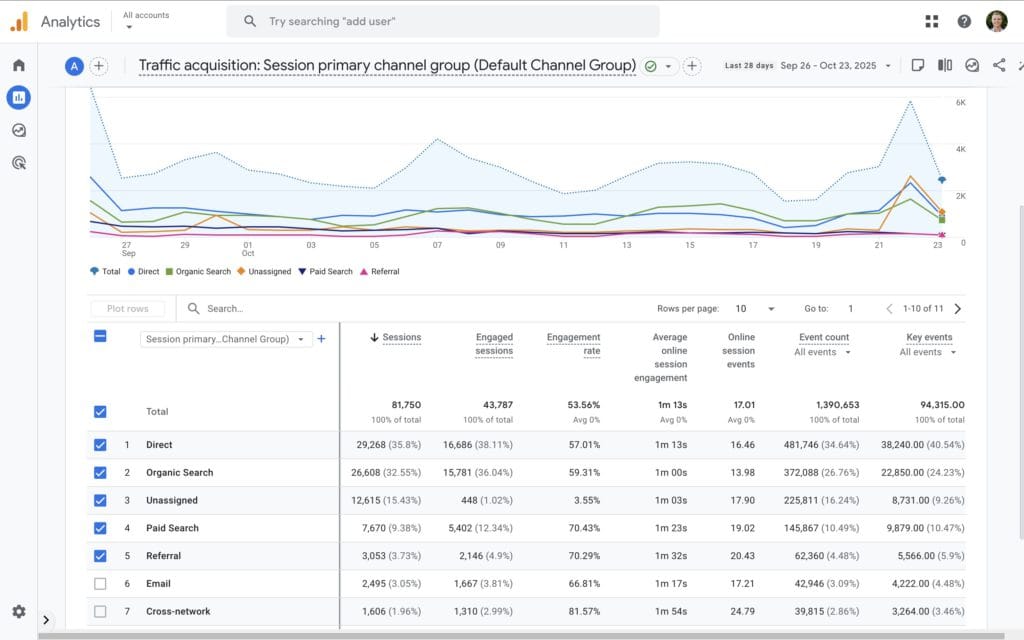
Maximize Your Insights with the Traffic Acquisition Report:
- Identify Your Top Traffic Sources: Assess which platforms are delivering the most visitors to your website. If you find that organic search is your leading source, consider increasing your investment in SEO strategies to leverage this advantage further.
- Evaluate Traffic Quality: Look beyond just visitor numbers; examine metrics like sessions per user and average engagement time to gain deeper insights into visitor interest and commitment levels.
- Strategically Allocate Your Marketing Budget: Direct your budget wisely towards channels that not only attract visitors but also engage them effectively and encourage repeat visits.
By understanding the origins of your audience, you can tailor your marketing focus to prioritise the channels that deliver the best outcomes. The report automatically showcases the various pathways users take to reach your website, but you can enhance its utility by tagging your inbound marketing campaigns. This strategic approach is particularly valuable when distributing newsletters or running advertising campaigns to drive traffic effectively.
Enhancing Google Analytics Tracking with Campaign Tagging URLs
Campaign-tagged URLs are meticulously constructed links to your website that include extra tracking information, known as query parameters, which enable Google Analytics to monitor your marketing initiatives with greater accuracy. By appending these parameters to your URLs, you unlock detailed insights into how visitors arrive at your site, providing data that goes beyond standard reports.
The Importance of Campaign Tagging URLs:
- Track Individual Marketing Campaigns: These URLs allow you to specify which marketing campaigns are effectively driving traffic to your site.
- Understand Visitor Origins: Gain clarity on the sources of your traffic, whether from newsletters, social media posts, or paid advertisements.
- Evaluate Campaign Performance: By analysing the data from tagged URLs, you can pinpoint your most successful campaigns and adapt your strategies accordingly.
Enhancing Acquisition Reports with Campaign Tagging URLs:
Google Analytics typically categorises traffic sources into organic search, direct, referral, and organic social. While this classification provides a foundational overview, it lacks the granularity needed to derive insights from specific campaigns or links.
Steps to Implement Campaign Tagging in Your URLs:
To effectively use campaign-tagged URLs, you will need to add specific parameters to your inbound links. The essential parameters include:
- utm_source – identifies the source of your traffic, such as a newsletter, Facebook, or Google.
- utm_medium – specifies the marketing medium, such as email, social media, or cost-per-click (CPC).
- utm_campaign – denotes the specific campaign name, like ‘spring sale' or ‘product launch'.
- utm_term (optional) – primarily used for paid search campaigns to identify specific keywords.
- utm_content (optional) – differentiates similar content or links within the same advertisement or campaign.
For example, here is a Tagged URL:
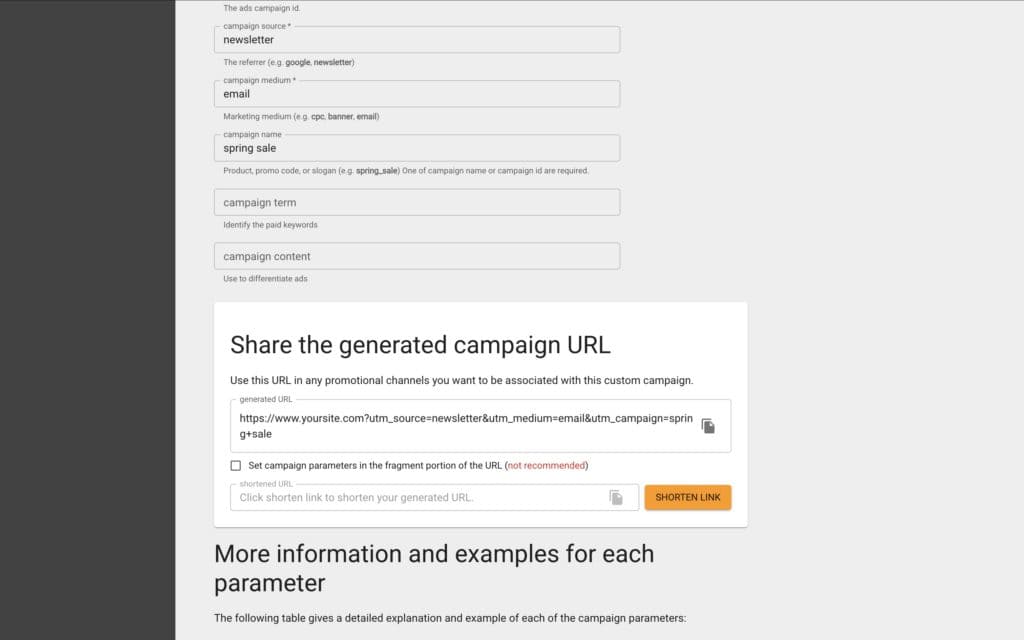
When a user clicks on this link, Google Analytics captures the parameters, allowing you to determine that the visitor came from your “spring sale” campaign via an email newsletter. By modifying your inbound links with campaign tags, you can effectively track how users discover your website.
In addition to creating campaign-tagged URLs, linking your Google Ads account with Google Analytics is also highly beneficial. You can access a tutorial video to guide you through this process:
2. Engagement Reports: Delve Deep into User Interactions on Your Website
Attracting traffic to your site is just one aspect of your marketing puzzle. The Engagement Reports provide vital insights into user behavior once they reach your site. Do they stay and explore your content, or do they leave almost immediately? Which pages capture their interest the most?
Within the Engagement section, the Pages and Screens report offers a thorough overview of all the pages users have interacted with on your website. This report enables you to identify your most and least engaging content effectively. Key metrics to monitor include:
- Views: The total number of times your pages have been accessed, allowing you to pinpoint content that resonates strongly with users.
- Views Per Active User: This metric reveals which content users are revisiting, indicating high interest or perceived value.
- Key Events: Monitor specific actions on particular pages, such as purchases, sign-ups, or other conversions. Setting up key events allows you to assess how effectively certain pages drive user actions and align with your business objectives.
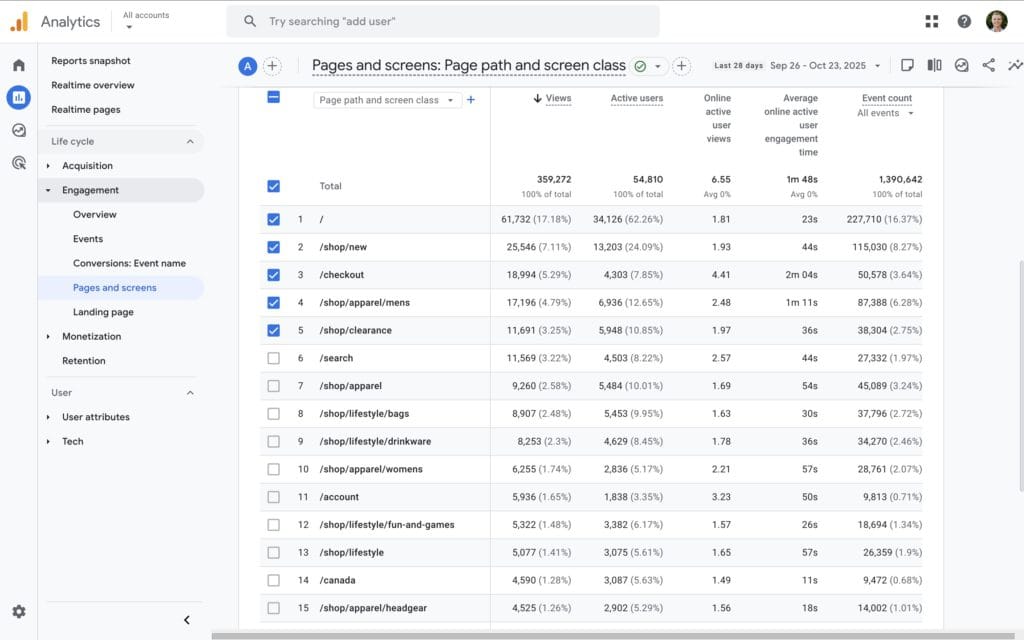
Utilise Key Insights to Improve Your Website:
- Enhance Your High-Performing Content: If certain blog posts or product pages are generating notable engagement, consider creating more similar content to sustain that interest.
- Improve Low-Engagement Pages: Identify pages with high bounce rates and implement strategic modifications to boost engagement, such as clearer calls to action or more captivating visuals.
- Personalise the User Experience: Ensure that navigation is user-friendly and content is relevant to keep visitors exploring your website for extended periods.
Prioritising user engagement is essential; your goal should not just be to increase page views, but to cultivate relationships that convert visitors into leads and loyal customers for your business.
3. Funnel Exploration Report: Strategically Design and Optimise User Journeys
Grasping how users navigate through your website is critical for enhancing conversion rates. The Funnel Exploration report in GA4 allows you to visualise the specific steps users take to complete a goal, such as making a purchase or signing up for a newsletter. This report helps you identify where users drop off in the conversion process, providing insights for optimising each stage to enhance the user experience.
Steps to Create an Effective Funnel Exploration Report in GA4:
Step 1: Set Up Your Report
- Navigate to the ‘Explore’ section.
- Click ‘Blank’ to start a new report.
- Select ‘Funnel Exploration’ from the dropdown menu under ‘Technique’.
Step 2: Define Your Funnel Steps
- Click the pencil icon next to ‘Steps’ to outline your funnel.
- Add a step for each stage in your user journey and assign it a descriptive name (e.g., ‘Visited Homepage’, ‘Viewed Product’, ‘Added to Cart’, ‘Completed Purchase’).
- For each step, select the event or page view that corresponds to that action.
For instance:
- Visited Homepage: Event name equals ‘page_view’ where page path equals ‘/’.
- Viewed Product: Event name equals ‘view_item’.
- Added to Cart: Event name equals ‘add_to_cart’.
- Completed Purchase: Event name equals ‘purchase’.
- After defining all steps, click ‘Apply’.
Step 3: Customize Your Funnel (Optional)
- Decide whether you want an ‘Open Funnel,’ allowing users to enter at any step, or a ‘Closed Funnel,’ where users must start at the first step.
- Set an optional timeframe for how long users have to complete the funnel.
- Add filters to focus on specific user criteria if necessary.
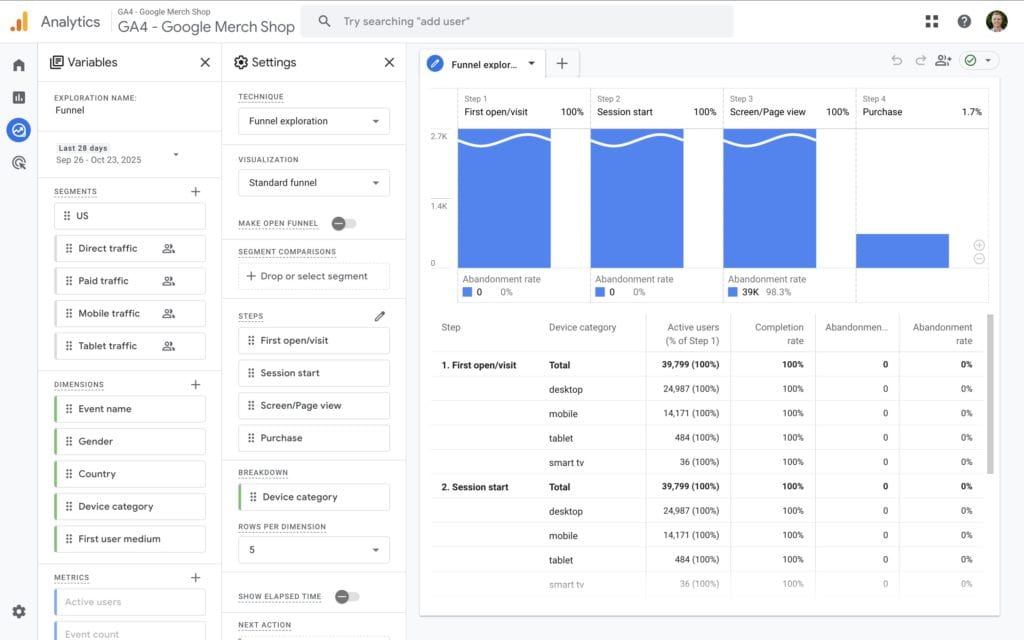
Maximize the Effectiveness of This Report By:
- Optimising Each Conversion Step: Assess each stage of your funnel to identify opportunities for enhancement. If a significant number of users exit during a specific step, consider simplifying the process or providing clearer guidance.
- Enhancing User Experience: Use insights from the funnel report to craft a more intuitive user journey. This might involve redesigning pages, improving loading speeds, or refining calls to action.
- Testing and Iterating for Improvement: Conduct A/B testing across your funnel stages to determine which changes result in higher conversion rates. Ongoing testing is crucial for refining the process over time.
- Personalising User Content: Customize the user experience based on segment behaviors. For example, if mobile users are dropping off at a certain step, refine that step for mobile devices.
Utilising the Funnel Exploration report empowers you to create a more efficient and effective path to conversion. By identifying and addressing weaknesses within your funnels, you can enhance the entire process and guide users towards your desired outcomes with greater ease.
4. Demographic Insights Report: Achieve a Comprehensive Understanding of Your Audience
The Demographic Insights report offers invaluable data on your audience's age, gender, location, and interests. This information is essential for personalising your content and campaigns to connect more effectively with your target audience, ultimately driving higher engagement and conversions.
Key Components to Focus on in the Demographic Report:
- Age and Gender Breakdown: Discover the age ranges and gender distribution of your audience to tailor your messaging and campaigns more effectively.
- Geographical Insights: Understand where your users are located to enhance your regional marketing efforts and time your campaigns strategically.
- Interests and Affinity Categories: Gain insights into your users' interests beyond your website to create captivating and engaging content that resonates with them.
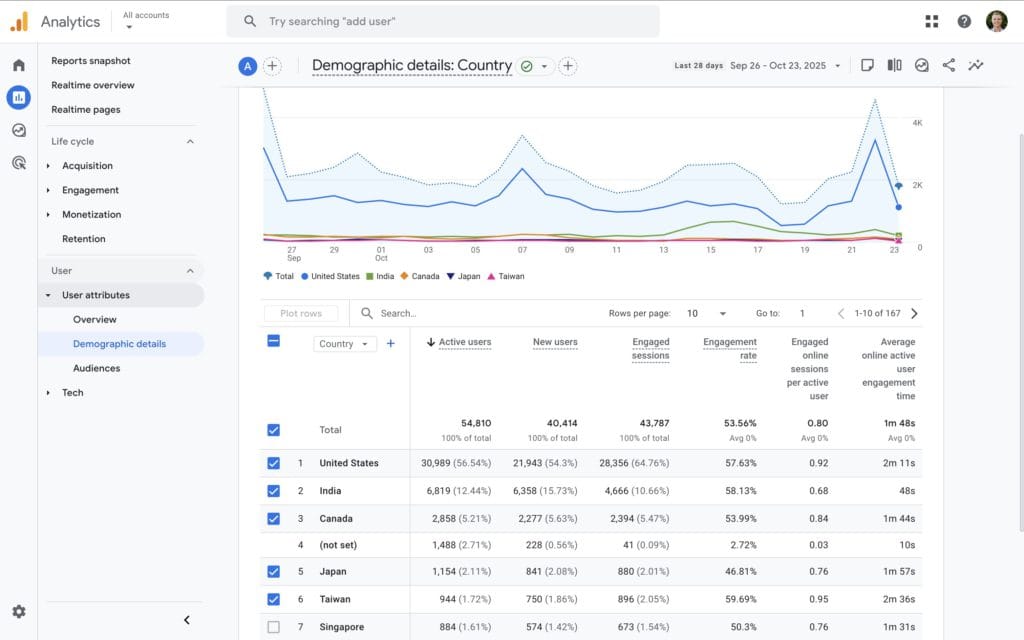
Effective Strategies Based on Demographic Insights:
- Personalise Your Content: Create content and marketing messages that align seamlessly with the preferences of your key demographic segments.
- Implement Precision Targeting in Advertising: Utilize demographic data to refine your ad targeting, ensuring your promotions reach the most receptive audience segments.
- Expand Your Market Reach: Identify underrepresented demographics that present growth opportunities and develop strategies to engage these potential customers.
By concentrating on demographic insights, you can craft marketing campaigns that are more relevant and impactful, effectively connecting with the specific needs and preferences of your audience.
5. Monetisation Report: Unlock Valuable Insights into Your Revenue Streams
For websites generating revenue, the Monetisation reports are indispensable. These reports provide a comprehensive overview of how users contribute to your financial success, allowing you to make data-driven strategic decisions.
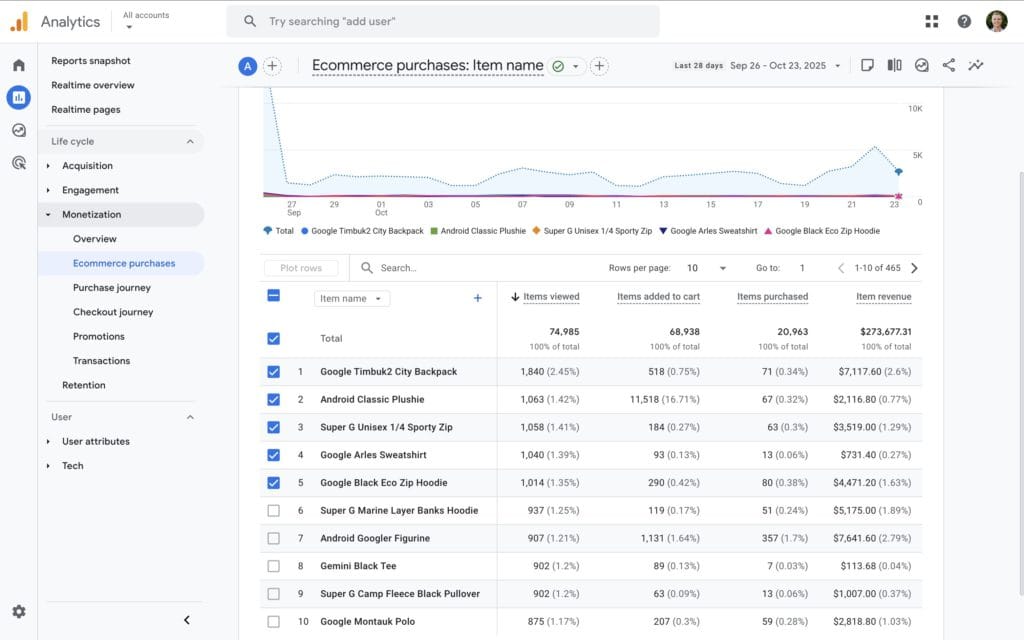
Key Metrics to Monitor for Financial Success:
- Total Revenue: The cumulative income generated over a specified period, offering a clear view of your financial performance.
- Average Purchase Revenue: The average revenue generated per transaction, aiding in the assessment of overall profitability.
- Purchases: Keep track of the frequency and types of products or services sold to gain insights into customer preferences and trends.
Leverage This Data to Enhance Your Revenue Streams:
- Identify Your Best-Selling Products: Focus your marketing efforts on products that yield the highest revenue.
- Enhance Product Visibility: Increase the attractiveness and visibility of your products to drive sales and boost revenue.
- Capitalize on Upselling and Cross-Selling Opportunities: Use purchasing data to recommend complementary products, thereby increasing the average order value.
A thorough understanding of your monetisation metrics empowers you to make informed decisions that enhance profitability and promote overall business growth.
Take Action Now to Master Google Analytics
By familiarising yourself with these five critical GA4 reports, you are establishing a solid foundation for marketing success powered by data-driven insights. Once you're ready to deepen your knowledge of Google Analytics, consider enrolling in a Google Analytics 4 Course to learn how to leverage these reports effectively and maximise this crucial business tool.
Keep in mind that successful marketing is not just about attracting visitors; it’s equally important to understand their needs and behaviors. Use the reports discussed here to gain deeper insights into your audience, refine your strategies, and watch your marketing initiatives thrive.
The post 5 Google Analytics Reports Every Marketer Should Know About appeared first on Ezi Gold.
The Article Essential Google Analytics Reports Every Marketer Needs Was Found On https://limitsofstrategy.com
The Article Google Analytics Reports Every Marketer Should Know First Appeared ON
: https://ad4sc.com
















Leave a Reply